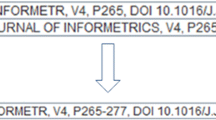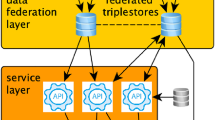Abstract
A sample of 1,483 publications, representative of the scholarly production of LIS faculty, was searched in Web of Science (WoS), Google, and Google Scholar. The median number of citations found through WoS was zero for all types of publications except book chapters; the median for Google Scholar ranged from 1 for print/subscription journal articles to 3 for books and book chapters. For Google the median number of citations ranged from 9 for conference papers to 41 for books. A sample of the web citations was examined and classified as representing intellectual or non-intellectual impact. Almost 92% of the citations identified through Google Scholar represented intellectual impact — primarily citations from journal articles. Bibliographic services (non-intellectual impact) were the largest single contributor of citations identified through Google. Open access journal articles attracted more web citations but the citations to print/subscription journal articles more often represented intellectual impact. In spite of problems with Google Scholar, it has the potential to provide useful data for research evaluation, especially in a field where rapid and fine-grained analysis is desirable.
Similar content being viewed by others
References
Antelman, K. (2004), Do open-access articles have a greater research impact? College & Research Libraries, 65(5): 372–382.
Bakkalbasei, N., Bauer, K., Glover, J., Wang, L. (2006), Three options for citation tracking: Google Scholar, Scopus and Web of Science. Biomedical Digital Libraries, 3. Retrieved August 28, 2006, from http://www.bio-diglib.com/content/pdf/1742-5581-3-7.pdf
Bakkalbasi, N., Goodman, D. (2004), Do science researchers use books? Paper presented at the XXIV Annual Charleston Conference: Issues in Book and Serial Acquisition, Charleston, South Carolina. PowerPoint slides retrieved June 23, 2006, from http://dlist.sir.arizona.edu/1106
Bauer K., Bakkalbasi, N. (2005), An examination of citation counts in a new scholarly communication environment. D-Lib Magazine, 11(9). Retrieved February 15, 2006, from http://www.dlib.org/dlib/september05/bauer/09bauer.html
Belew, R. K. (2005), Scientific Impact Quantity and Quality: Analysis of Two Sources of Bibliographic Data. Retrieved September 6, 2006, from arXiv:cs.IR/0504036v1
Broadus, R. M. (1971), The literature of the social sciences: A survey of citation studies. International Social Science Journal, 23(2): 236–243.
Cronin, B. (2005), A hundred million acts of whimsy. Current Science, 89(9): 1505–1509. Retrieved June 12, 2006, from http://www.ias.ac.in/currsci/nov102005/1505.pdf
Davis, P. M. (2006), Do Open-Access articles really have a greater research impact? College & Research Libraries, 67(2): 103–104. Retrieved August 25, 2006, from http://hdl.handle.net/1813/2881
Devin, R. B., Kellogg, M. (1990), The serial/monograph ratio in research libraries: Budgeting in light of citation studies. College & Research Libraries, 51(1): 46–54.
Harnad, S. (2006), Let 1000 RAE metric flowers bloom: Avoid Matthew effect as self-fulfilling prophecy [posting to the ASIST SIG/Metrics listserv]. Retrieved June 23, 2006, from http://listserv.utk/edu/cgi-bin/wa?A2=ind0606&L=sigmetrics&D=1&O=D&F=&S=&P=8071
Jacsó, P. (2005a), As we may search — comparison of major features of the Web of Science, Scopus, and Google Scholar citation-based and citation-enhanced databases. Current Science, 89(9): 1537–1547. Retrieved January 4, 2006, from http://www.ias.ac.in/currsci/nov102005/1537.pdf
Jacsó, P. (2005b), Comparison and analysis of the citedness scores in Web of Science and Google Scholar. Digital Libraries: Implementing Strategies and Sharing Experiences, Proceedings of the International Conference on Asian Digital Libraries (Lecture Notes in Computer Science, 3815), 360–369. Retrieved June 12, 2006, from http://projects.ics.hawaii.edu/:_jacso/PDFs/jacso-comparison-analysis-of-citedness.pdf
Jacsó, P. (2005c), Google Scholar and The Scientist. Retrieved June 12, 2006, from http://www2.hawaii.edu/:_jacso/extra/gs
Kousha, K., Thelwall, M. (2006), Motivations for URL citations to open access library and information science articles, Scientometrics, 68: 501–517.
Kousha, K., Thelwall, M. (2007), Google Scholar citations and Google Web/URL citations: A multidiscipline exploratory analysis. Journal of the American Society for Information Science and Technology, 58(7): 1055–1065.
Kurtz, M. J. (2004), Restrictive Access Policies Cut Readership of Electronic Research Journal Articles by a Factor of Two. Cambridge, MA: Harvard-Smithsonian Center for Astrophysics. Retrieved June 12, 2006, from http://opcit.eprints.org/feb19oa/kurtz.pdf
Lawrence, S. (2001), Online or invisible? Nature, 411(6837): 521.
Meho, L. I. (2006), The End of Monopoly: Citation Analysis beyond Web of Science. Submitted for publication.
Meho, L. I., Spurgin, K. M. (2005), Ranking the research productivity of library and information science faculty and schools: An evaluation of data sources and research methods. Journal of the American Society for Information Science and Technology, 56(12): 1314–1331.
Meho, L. I., Yang, K. (2007), Impact of data sources on citation counts and rankings of LIS faculty: Web of Science, Scopus, and Google Scholar. Journal of the American Society for Information Science and Technology, 58(13): 2105–2125.
Merton, R. K. (1968), The Matthew Effect in science. Science, 159(3810): 56–63.
Noruzi, A. (2005), Google Scholar: The new generation of citation indexes. Libri, 55(4): 170–180.
Neuhaus, C., Neuhaus, E., Asher, A., Wrede, C. (2006), The depth and breadth of Google Scholar: An empirical study. Portal: Libraries and the Academy, 6(2): 127–141.
Pauly, D., Stergiou, K. I. (2005), Equivalence of results from two citation analyses: Thomson ISI’s citation index and Google’s scholar service. Ethics in Science and Environmental Politics, 2005: 33–35.
Roth, D. L. (2005), The emergence of competitors to the Science Citation Index and the Web of Science. Current Science, 89(9): 1531–1536.
Schaffer, T. (2004), Psychology citations revisited: Behavioral research in the age of electronic resources. The Journal of Academic Librarianship, 30(5): 354–360.
Shadbolt, N., Brody, T., Carr, L., Harnad, S. (2006), The open research web: A preview of the optimal and the inevitable. In N. Jacobs (Ed.), Open Access: Key Strategic, Technical and Economic Aspects. Retrieved June 23, 2006, from http://eprints.ecs.soton.ac.uk/12453
Simboli, B. (2006), Professional Associations and Impact Factors [posting on the CHEMINF-L listserv]. Retrieved June 23, 2006, from https://listserv.indiana.edu/cgi-bin/wa-iub.exe?A2=ind0606&L=chminf-1&T=0&P=2608
Van Impe, S., Rousseau, R. (2006), Web-to-print citations and the humanities. Information: Wissenschaft und Praxis, 57(8): 422–426.
Vaughan, L., Shaw, D. (2003), Bibliographic and web citations: What is the difference? Journal of the American Society for Information Science and Technology, 54(14): 1313–1322.
Vaughan, L., Shaw, D. (2005), Web citation data for impact assessment: A comparison of four science disciplines. Journal of the American Society for Information Science and Technology, 56(10): 1075–1087.
Zhao, D. Z. (2005), Challenges of scholarly publications on the web to the evaluation of science: A comparison of author visibility on the web and in print journals. Information Processing & Management, 41(6): 1403–1418.
Author information
Authors and Affiliations
Corresponding author
Rights and permissions
About this article
Cite this article
Vaughan, L., Shaw, D. A new look at evidence of scholarly citation in citation indexes and from web sources. Scientometrics 74, 317–330 (2008). https://doi.org/10.1007/s11192-008-0220-2
Received:
Published:
Issue Date:
DOI: https://doi.org/10.1007/s11192-008-0220-2




